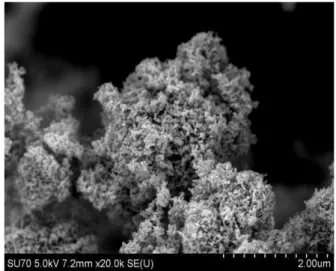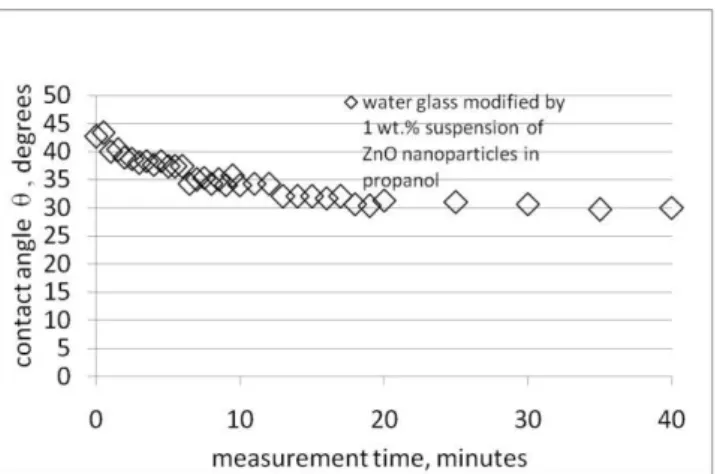A R C H I V E S
o f
F O U N D R Y E N G I N E E R I N G
Published quarterly as the organ of the Foundry Commission of the Polish Academy of Sciences
ISSN (1897-3310) Volume 12 Special Issue
2/2012
37 – 40
7/2
A R C H I V E S o f F O U N D R Y E N G I N E E R I N G V o l u m e 1 2 , S p e c i a l I s s u e 2 / 2 0 1 2 , 3 7 - 4 0 37
Effect of water glass modification with
nanoparticles of zinc oxide on selected
physical and chemical properties of binder
and mechanical properties of sand mixture
A. Kmita
*, B. Hutera, E. Olejnik, A. Janas
AGH University of Science and Technology in Cracow, Faculty of Foundry Engineering, Cracow, Poland *Corresponding author. E-mail address: akmita@agh.edu.pl
Received 31.07.2012; accepted in revised form 05.09.2012
Abstract
In this paper, an attempt was made to use the ZnO nanoparticles as a modifier of foundry binder - water glass. The modifier was a colloidal suspension of the ZnO zinc oxide nanoparticles in propanol. A thermal method to obtain metal oxide nanoparticles was adopted. The modifier was product of the thermal decomposition of the basic zinc carbonate ([ZnCO3]2•[Zn(OH)2]3), and was introduced into the water glass in an amount of 1 and 3 wt%. To determine the interfacial reactions taking place in a quartz - modified water glass system, the binder wettability of the quartz grains was measured. The effect of water glass modification on the mechanical properties of moulding sands was verified by testing the tensile strength Rmu of moulding sands with the modified binders. Water glass modification with the colloidal solution of ZnO nanoparticles in propanol confirmed the effect of modifier on the water glass wettability of sand grains and on the mechanical properties of the sand mixtures with this additive.
Keywords: Thermal synthesis of ZnO nanoparticles, Wettability, Tensile strength Rmu of moulding sands
1. Introduction, and aim and scope of
the research
Nanoparticles as a new generation of materials are used in many fields. The basic methods for their preparation are the top-down and bottom-up techniques. The essence of the top-top-down technique consists in grinding the material to particles with nano dimensions, while the bottom-up technique assumes making structures from molecules or single atoms [1,2]. According to a method recently developed, the nanoparticles of metal oxides are produced through anodic dissolution of metals [3]. There are also thermal methods of obtaining metal nanoxides [4-7].
The ZnO nanoparticles enjoy a wide range of various applications, including the industry of chemicals and cosmetics, dentistry, etc.
The results of studies presented in the literature stress the positive impact of nanoparticles as modifiers of binders for moulding sands [8-10].
Studies of foundry sands with water glass [8,9,11] have shown that the modification of binder has positive effect on the reduction of residual strength, which is associated with improved knocking out properties.
A R C H I V E S o f F O U N D R Y E N G I N E E R I N G V o l u m e 1 2 , S p e c i a l I s s u e 2 / 2 0 1 2 , 3 7 - 4 0 38
changes its original properties, and therefore both structure and morphology of this material are so important in this case.
In this study, an attempt was made to carry out the modification of water glass with zinc nanoxide. The aim of the research was to determine what effect the modifier added to binder may have on the wettability of quartz sand grains and on the mechanical properties of the resulting moulding sand mixture.
2. Experimental
2.1. Test materials and methods
Modification was carried out on sodium water glass type R „145 ” characterised by a modulus M = 2.5, the density d20 = 1470 kg/m3, and pH = 11.2.
The nanoparticles of ZnO (Figs.1, 2), were obtained by thermal decomposition of the basic zinc carbonate ([ZnCO3]2•[Zn(OH)2]3).
Fig. 1. SEM image of ZnO zinc oxide nanoparticle, x 20 k
Fig. 2. SEM image of ZnO zinc oxide nanoparticle, x 100 k
The water glass modifier was a suspension of ZnO nanoparticles in propanol at a fixed concentration of c = 0.3 M and with the grain size of about 60 nm.
2.2. Test apparatus and equipment
The size of nanoparticles was determined using a SEM Philips XL30 with LINK ISIS EDX system and ESEM Philips.
Water glass modification consisted in introducing 1 and 3 wt% of a colloidal suspension of the ZnO nanoparticles in propanol, followed by thorough homogenisation of the whole mixture.
Quartz wettability was determined using a prototype device for the measurement of contact angle. Wetting of the quartz grains in a quartz-water glass system was determined examining changes in the value of the contact angle in time until full stabilisation of this value has been reached.
The sand mixture strength properties were determined in a tensile test after 24 h hardening in air.
3. Results and discussion
Figures 3,4,5 show changes in the value of the contact angle in a quartz-binder system. Figure 3 illustrates the quartz wetting characteristics using an unmodified binder, while Figures 4 and 5 show the results of analogical measurements taken for the binder modified with 1 or 3 wt.% of the modifier.
The unmodified water glass shows inadequate wetting of the surface of the quartz grains (Fig. 3). Changes of contact angle in time are characterised by high values of both the initial contact
angle θ0 (about 45 deg.) and the equilibrium angle θr (about 33 deg.), and by a long time τr the system needs to enter into a steady state (about 20 min.).
Fig. 3. Time-related changes in the value of contact angle in a quartz-unmodified water glass system. Measurement temperature:
A R C H I V E S o f F O U N D R Y E N G I N E E R I N G V o l u m e 1 2 , S p e c i a l I s s u e 2 / 2 0 1 2 , 3 7 - 4 0 39 Fig. 4. Time-related changes in the value of contact angle in a
quartz-modified water glass system (1 wt.% suspension of thermal ZnO nanoparticles in propanol).
Measurement temperature: 20oC
The time-related changes in the contact angle values plotted in Figure 4 are characterised by similar values: θ0(about 45 deg), θr (about30 deg) and τr (about 20 min.).
As it follows from the studies carried out so far, the modification of binder with a 3 wt.% addition of the examined modifier (Fig. 5) increases the quartz wettability, which is manifested in a drop of the angles: θ0 (to about 17 deg) and θr (to about 7 deg), and shorter time τr (to about 6 min.) needed by the quartz-binder system to reach a steady state.
Fig. 5. Time-related changes in the value of contact angle in a quartz-modified water glass system ( 3 wt.% suspension of
thermal ZnO nanoparticles in propanol). Measurement temperature: 20oC
Figure 6 shows the collective results of the tensile test RmU carried out on moulding sands with water glass unmodified and modified with 1 and 3 wt.% of modifier after different times of hardening. For further analysis, the results of the tensile test after 24 h were adopted.
Tensile tests have confirmed the effect of modification on the tensile strength Rm
U
. An increase of Rm U
by about 25% is visible in sands containing binder modified with 1 wt.% of the modifier,
while modification with 3 wt.% has made the value of Rm U
drop by about 7%.
Fig. 6. Effect of maturing time on the tensile strength Rmu of loose self-setting sands with water glass. Sand composition (in parts by weight): 1)‘Szczakowa’ silica sand - 100, water glass
‘145’- 3, 2) Modifier: 1 wt.% suspension of ZnO thermal
nanoparticles in propanol, calculated in respect of binder, 3)
Modifier: 3 wt. % suspension of ZnO thermal nanoparticles in propanol, calculated in respect of binder. Hardening in air.
Hardening conditions: t ot ≈ 24 0C; moisture ≈ 51%.
4. Summary
Water glass modification with the suspension of ZnO nanoparticles in propanol (obtained by thermal technique) shows an impact on the sand grains wettability and improvement of the sand strength after hardening. The wettability improvement has been observed with an addition of 1 wt.% of the modifier, while an increase of the sand strength (by about 25 wt.%) followed the addition of 3 wt.% of the modifier.
Acknowledgements
Studies were performed under the „Dean’s Grant” 2012 No.
15.11.170.419
References
[1] Dietl T.: Nanotechnologie przyszłości, Polska Akademia
Umiejętności, Prace Komisji Zagrożeń Cywilizacyjnych, 7,
s. 15–28, 2006.
[2] Komisja Europejska: EUR 21152 – Nanotechnologia –
Innowacja dla świata przyszłości, Urząd Oficjalnych
Publikacji Wspólnot Europejskich, Luksemburg, 2007
[3] B. Stypuła, J. Banaś, T. Habdank-Wojewódzki, H. Krawiec,
A R C H I V E S o f F O U N D R Y E N G I N E E R I N G V o l u m e 1 2 , S p e c i a l I s s u e 2 / 2 0 1 2 , 3 7 - 4 0 40
[4] Darezereshki, E. Alizadeh, M. Bakhtiari, F. Schaffie, M. Ranjbar. M. (2011) . A novel thermal decomposition method for the synthesis of ZnO nanoparticles from low concentration ZnSO4 solutions.Applied Clay Science 54
pp.107–111. DOI: 10.1016/j.clay.2011.07.023.
[5] Fan, H. Song, B. Liu, J. Yang, Z. Li. Q. (2005). Thermal formation mechanism and size control of spherical hematite nanoparticles. Materials Chemistry and Physics 89 pp. 321–
325. DOI: 10.1016/j.matchemphys.2004.09.021.
[6] M.Shamsipur, S.M. Pourmotazavi, S. S. Hajimirsadeghi, M.M. Zahedi, M. Rahimi-Nasradabi (2012) : Facile synthesis of zinc carbonate and zinc oxide nanoparticles via direct carbonation and thermal decomposition. Ceramics
International, DOI: 10.1016/j.ceramint.2012.07.003
[7] Koga N., Tanaka H. (2005): Thermal decomposition of copper (II) and zinc carbonate hydrooxides by means of
TG-MS.: Journal of Thermal Analysis and Calorimetry, vol 82 752-729, DOI: 10.1007/s10973-005 6866-6
[8] Kmita A, Hutera B, DrożyńskiD. (2010) Effect of sodium silicate modification on selected properties of loose self-setting sands. Archives of Foundry Engineering vol.10 issue 4 pp.93–96
[9] Hutera B, Stypuła B, Kmita A, Nowicki P.
(2011)Modification of water glass with colloidal slurries of metal oxides. Archives of Foundry Engineering vol.11 iss. 4 pp 51–54
[10]Ji-na, W. Zi-tian, F. Hua-feng, W. Xuan-pu, D. H. Nai-yu. (2007). An improved sodium silicate binder modified by ultra-fine powder materials. China Foundry vol.4.No.1,
pp.26-30. DOI: 1672-6421(2007)01-026-05.

